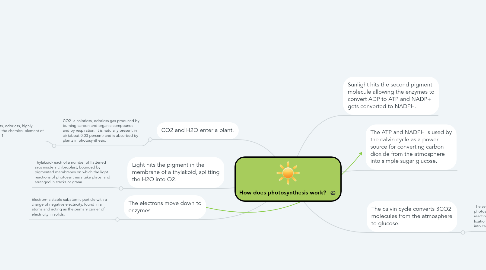How does photosynthesis work?
by Mikhala Bromfield

1. CO2 and H2O enter a plant.
1.1. CO2- a colorless, odorless gas produced by burning carbon and organic compounds and by respiration. It is naturally present in air (about 0.03 percent) and is absorbed by plants in photosynthesis.
1.1.1. H2O- a colorless, odorless, highly flammable gas, the chemical element of atomic number 1.
2. Light hits the pigment in the membrane of a thylakoid, splitting the H2O into O2.
2.1. Thylakoid- each of a number of flattened sacs inside a chloroplast, bounded by pigmented membranes on which the light reactions of photosynthesis take place, and arranged in stacks or grana.
3. The electrons move down to enzymes.
3.1. Electron- a stable subatomic particle with a charge of negative electricity, found in all atoms and acting as the primary carrier of electricity in solids.
4. Sunlight hits the second pigment molecule allowing the enzymes to convert ADP to ATP and NADP+ gets converted to NADPH.
5. The ATP and NADPH is used by the calvin cycle as a power source for converting carbon dioxide from the atmosphere into simple sugar glucose.
6. The calvin cycle converts 3CO2 molecules from the atmosphere to glucose.
6.1. The second of two major stages in photosynthesis (following the light reactions), involving atmospheric CO2 fixation and reduction of the fixed carbon into carbohydrate.


